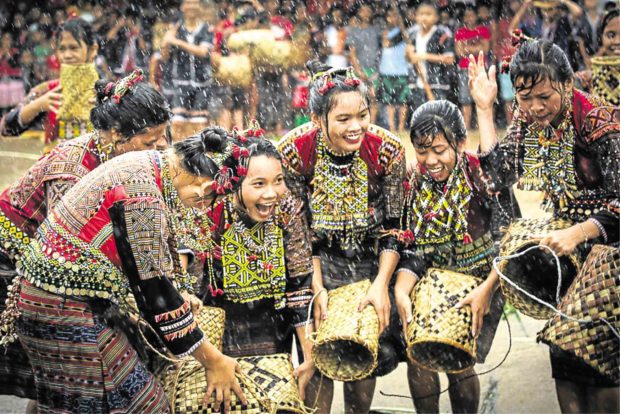
Amid a heavy downpour, students in their traditional Mandaya attire continue performing during the Kalindugan Festival. —PHOTOS BY EDEN JHAN LICAYAN
CARAGA, DAVAO ORIENTAL — Christine Banugan, 26, takes her role seriously as the new “likid,” or chieftain, of a cluster of Mandaya communities of mostly aging people in the upland village of Pichon in this town.
“It’s not easy to lead people, especially when you are younger than most of the people you lead,” she said on the sidelines of the Kalindugan Festival in Sangab, where she was formally introduced as “lumad” (indigenous) leader.
Her tribe calls her Kring-Kring, a term of endearment that does not appropriately describe the extent of her rule — 14,000 hectares of ancestral land and at least 7,000 people. A council of elders, or “magkatadong,” gives her advice.
Sitio Sangab is perched in a mountainous area caressing the clouds between Davao Oriental and Compostela Valley provinces. The land is covered by a certificate of ancestral domain, one of a few titles issued 19 years ago by the National Commission on Indigenous Peoples to lumad groups in southern Mindanao.
Battleground
Its festival, Kalindugan (Mandaya for rise up), celebrates the sense of autonomy that the community acquired with its title.
Like other upland villages, Sangab was once a battleground of government forces and communist rebels. Its surrounding forests were training ground for rebel recruits in the mid-1980s.
The resistance by some tribe leaders, including Christine’s father, Copertino, to rebel incursions has led to killings.
Just last year, on New Year’s Eve, Copertino himself and several of his relatives were killed, allegedly by rebels who raided the family compound in the Caraga town center. Copertino had been known to be close to the military and had banned rebels in his community.
Mandaya leader Christine Banugan (seated) is blessed by Sangab’s chief priestess.
“I miss him,” said Christine during the festival, as schoolchildren in Mandaya costumes shouted and danced to indigenous music produced by bamboo instruments and amid a downpour.
Christine is not used to the daily grind of Mandaya life. She had spent time in Davao City, working as a junior business executive.
Her closest encounter with tribal politics was to be an assistant to her father and usherette in community events.
When her father died, there was some confusion on who would be the next likid. Several elders had told Christine that she should be his successor.
“I was hesitant,” she said. But elders and relatives vowed to support and help her.
Military watch
Though threats from rebels hardly exist at present, the military is keeping a close watch on Sangab.
Col. Jacob Obligado, head of the Army’s 67th Infantry Battalion, said communities, such as Sangab, were vulnerable to attacks by New People’s Army rebels.
One of the military’s objectives in Sangab was to help attain food security for the tribe, according to Brig. Gen. Reuben Basiao, commander of the Army’s 701st Infantry Brigade.
Most of the residents subsist on corn and abaca farming. Some work in small-scale gold mines in Compostela Valley.
Christine said that while she was grateful for the support of local and provincial governments, more was needed.
For her, the task is daunting but inescapable.